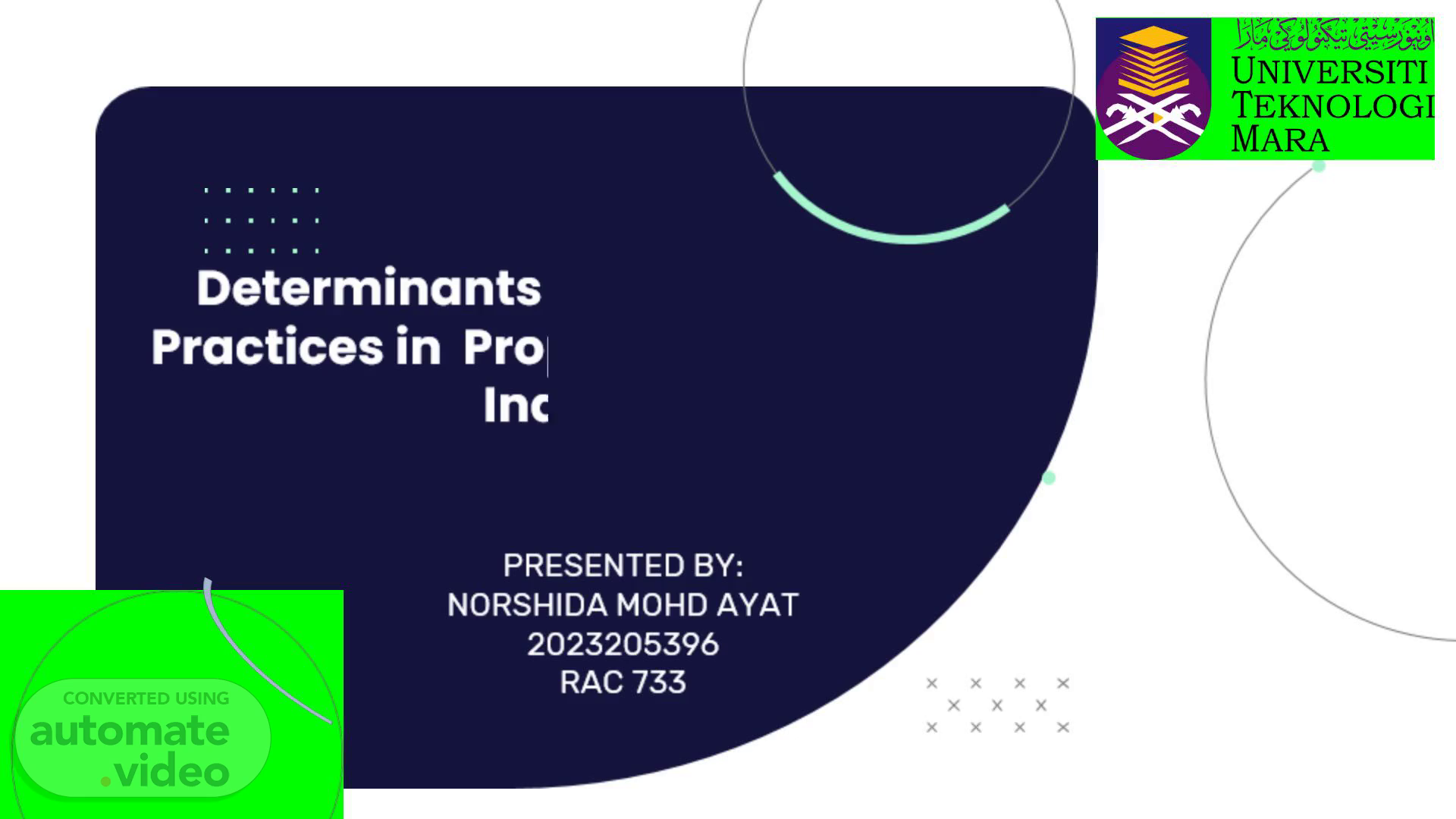
Determinants of Tax Avoidance Practices in Property Development Industry
Scene 1 (0s)
Determinants of Tax Avoidance Practices in Property Development Industry.
Scene 2 (23s)
[Audio] We are exploring the effect firm size, profitability and leverage have on tax avoidance practices in the property development industry. Our research aims to answer three questions. Firstly, does firm size play a part in tax avoidance? Secondly, does profitability have an impact on tax avoidance? Lastly, what is the role of leverage in relation to tax avoidance? These questions form the basis of our exploration and help us to understand the complex dynamics at play when it comes to tax avoidance..
Scene 3 (58s)
[Audio] The slide number three provides the theoretical framework of the research with independent and dependent variables along with the underlying theories related to tax avoidance practices in the property development industry. The table displays a comprehensive overview of the variables used to evaluate the tax avoidance practices, including firm size, profitability, leverage, capital intensity, etc. Through recognizing the theoretical framework of the research, we can gain information about the variables utilized to analyze the impacts of tax avoidance on the property development industry..
Scene 4 (1m 37s)
[Audio] This slide presents the empirical schema for our research on tax avoidance practices in the property development industry. We will be examining five main factors, namely firm size, profitability, leverage, capital intensity, and independent and dependent variables. Our research will be focusing on three areas, H1, H2 and H3, with all of them displaying a positive correlation between the independent and dependent variables..
Scene 5 (2m 9s)
[Audio] In order to study tax avoidance practices in the property development industry, the research design for this project requires understanding the purpose of the study, the causal study and the unit of analysis, as well as considering the extend of researcher interference, the sampling design, the study setting, the time horizon and the measurement and the operational definition. Additionally, the data collection and the research strategies - such as the use of internal source databases - must be decided..
Scene 6 (2m 43s)
[Audio] Without greetings, beginning with Today, and thanks: Slide number 6 of this study is about the determinants of tax avoidance practices in the property development industry. This slide outlines the sampling process. The study was focused on developer taxpayers in the Klang Valley branches, who had their cases resolved by the Desk Auditor for the year of assessment 2019. From the 139,370 cases, 15,363 were collected from 8 branches and 6,631 were available for analysis after selection based on the requirements. Stratified random sampling was used to obtain a sample population with proportional calculation from the 6,631 available cases divided by industry and branch. In the end, 500 cases were selected as the sample size..
Scene 7 (3m 42s)
[Audio] For this study, Disproportionate Stratified Sampling was used to select the samples. This means that the samples were selected based on certain percentage from each area in Klang Valley. The total number of tax audit cases resolved in Klang Valley for the year 2019 was 15,363. After eliminating cases with incomplete information, the total number of tax audit cases resolved was 6,631. Consequently, 500 total samples or cases were selected for this study..
Scene 8 (4m 24s)
[Audio] We discuss the data source and data collection methods for our presentation. Secondary data and internal data from the Inland Revenue Board of Malaysia (IRBM) for the financial year 2019 was used. A quantitative research method was employed to collect the data which was analyzed using the Statistical Package for Social Science (SPSS) version 26..
Scene 9 (4m 50s)
[Audio] We will be discussing the various determinants affecting tax avoidance practices in the property development industry. A few variables used to measure such practices include firm size, profitability, leverage and capital intensity. Firm size can be evaluated by comparing total assets, while profitability by the return on equity. Leverage is measured by the debt to equity ratio and capital intensity by the comparison of fixed assets to total assets. Let's examine this subject further to understand how all these elements interact..
Scene 10 (5m 41s)
[Audio] The multiple linear regression model is used to test the hypotheses of this study. It includes size of firms, profitability, leverage, capital intensity and institutional ownership as its variables. This model enables us to evaluate the impact of these variables on tax avoidance. Gaining an insight into the determinants of tax avoidance is possible by analyzing these variables' effect on tax avoidance activities..
Scene 11 (6m 10s)
[Audio] Slide 11 is about the techniques used to analyze the data in order to identify the determinants of tax avoidance practices in the property development industry. The techniques discussed in this slide include descriptive statistics, correlation of variables, and multiple regression analysis. Descriptive statistics allow us to summarize and describe the data, while correlation of variables allows us to measure the relationship between variables. Finally, multiple regression analysis allows us to identify the most significant factors influencing tax avoidance behavior..
Scene 12 (6m 47s)
[Audio] The determinants of tax avoidance practices in property development industry are discussed in this slide. Taxation policies, market and economic conditions, owner-manager characteristics and the availability of tax loopholes are among these factors. Having knowledge of these factors can help reduce the likelihood of property developers taking on tax avoidance practices, which can ultimately lead to increased tax revenues for governments and more contribution from the property development industry to society..